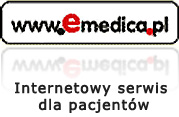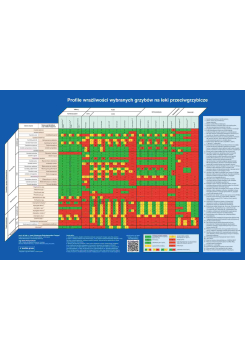
- Alergologia
- Anestezjologia/ Intensywna terapia
- Angiologia
- Antybiotykoterapia
- Chirurgia/Ortopedia
- Choroby zakaźne i pasożytnicze/Szczepienia
- Diabetologia
- Gastroenterologia
- Historia / Biografie / Wspomnienia
- Interdyscyplinarne
- Kardiologia
- Neonatologia
- Neurologia / Neurochirurgia
- Okulistyka/Optometria
- Onkologia
- Otorynolaryngologia
- Pediatria
- Pneumonologia
- Poza medycyną (Sport / Turystyka / Inne)
- Położnictwo i ginekologia
- Psychiatria / Psychologia
- Stomatologia
- Słowniki / Atlasy
Plakat "Profile wrażliwości wybranych grzybów na leki przeciwgrzybicze"
Dostępność: Dostępny
Czas wysyłki: 48 godzin
Wydanie: edycja: grudzień 2024
Rok: 2024
Format: 680x480 mm
Oprawa: sztywny karton 300 g, z otworem na zawieszenie
- Opis
- Linki (1)
1. Arendrup M.C. et al: ESCMID and ECMM joint clinical guidelines for the diagnosis and management of rare invasive yeast infection. Clinical Microbiology and Infection, 2014, 20 (Suppl. 3) https://doi.org/10.1111/1469-0691.12360
2. Aspergillus and Aspergillosis website: https://www.aspergillus.org.uk/
3. Boutin C.A.: Update on therapeutic approaches for invasive fungal infections in adults. Ther. Adv. Infect. Dis. 2024, 11:20499361231224980.
4. Buchta et al.: Saprochaete clavata invasive infection – a new threat to hematological-oncological patients. Frontiers in Microbiology 2019, 10:2196 doi: 10.3389/fmiob.2019.021963
5. Chen S.C., Perfect J., Colombo A.L. et al.: Global guideline for the diagnosis and management of rare yeast infections: an initiative of the ECMM in cooperation with ISHAM and ASM. Lancet Infect. Dis. 2021;21:e375-e386
6. Chowdhary A. et al.: A multicentre study of antifungal susceptibility patterns among 350 Candida auris isolates (2009-17) in India: role of the ERG11 and FKS1 genes in azole and echinocandin resistance. Journal of Antimicrobial Chemotherapy, 2018, 73.
7. Cornely O.A. et al.: ESCMID and ECMM joint clinical guidelines for the diagnosis and management of mucormycosis 2013. Clinical Microbiology and Infection, 2014, 20 (Suppl. 3) https://doi.org/10.1111/1469-0691.12371
8. Cornely O.A. , Alastruey-Izquierdo A., Arenz D. et al.: Global guideline for the diagnosis and management of mucormycosis: an initiative of the European Confederation of Medical Mycology in cooperation with the Mycoses Study Group Education and Research Consortium. Lancet Infect. Dis. 2019;19:e405-e421.
9. Cortegiani A. et al.: Epidemiology, clinical characteristics, resistance, and treatment of infections by Candida auris. Journal of Intensive Care, 2018, 6:69, https://doi.org/10.1186/s40560-018-0342-4
10. Desnos-Ollivier M.: Isavuconazole MIC distribution of 29 yeast species responsible for invasive infections (2015-2017). Clinical Microbiology and Infection, 2019; 25:634.e1e634.e4, DOI: https://doi.org/10.1016/j.cmi.2019.02.007
11. Dromer F., Bretagne S., Lortholary O.: Rapport annuel d'activité 2019. Centre de National de Référence Mycoses Invasives et Antifongiques Année d'exercice 2018.
12. European Committee on Antimicrobial Susceptibility Testing, Breakpoint tables for interpretation of MICs for antifungal agents, Version 11.0. valid from 2024.12.02.
13. Falci D.R., Pasqualotto A.C.: Profile of isavuconazole and its potential in the treatment of severe invasive fungal infections. Infection and Drug Resistance, 2013, 22 (Suppl. 6).
14. FDA Briefing Document. Anti-lnfective Drugs Advisory Committee Meeting (2015). Invasive Aspergillosis and Invasive Mucormycosis. NDA 207-500: Cresemba® (Isavuconazonium) for Injection; NDA 207-501 Cresemba® (Isavuconazonium) Capsules.
15. Feuss A. et al.: The Role of Olorofim in the Treatment of Filamentous Fungal Infections: A Review of In Vitro and In Vivo Studies. J. Fungi 2024, 10, 345.
16. Frederic Tissot et al.: ECIL-6 Guidelines For The Treatment Of Invasive Candidiasis, Aspergillosis and Mucormycosis in Leukemia and Hematopoietic Stem Cell Transplant Patients. Haematologica, 2017, 102 Doi:10.3324/haematol.2016.152900
17. Francisco E.C. et al.: Species distribution and antifungal susceptibility of 358 Trichosporon clinical isolatescollected in 24 medical centres. Clinical Microbiology and Infections, 2019, 25 (Suppl. 7) https://doi.org/10.1016/j.cmi.2019.03.026
18. Gil L., Kałwak K., Piekarska A. et al.: Antifungal management in adults and children with ematological malignancies or undergoing hematopoietic cell transplantation: recommendations of Polish Society of Hematology and Blood Transfusion, Polish Society of Pediatric Oncology and Hematology, and Polish Adult Leukemia Study Group, 2020. Acta Haematologica Polonica 2020; 51:60-72.
19. Guidelines for the diagnosis, prevention and management of cryptococcal disease in HIV infected adults, adolescents and children: supplement to the 2016 consolidated guidelines on the use of antiretroviral drugs for treating and preventing HIV infection. ISBN 978-92-4-155027-7, World Health Organisation, 2018.
20. Hoenigl M., Salmanton-García J., Walsh T.J. et al.: Global guideline for the diagnosis and management of rare mould infections: an initiative of the European Confederation of Medical Mycology in cooperation with the International Society for Human and Animal Mycology and the American Society for Microbiology. Lancet Infect. Dis. 2021;21:e246-e257.
21. International Commission of Penicillium and Aspergillus. A Commision of the International Union of Microbiological Societies https://www.aspergilluspenicillium.org/
22. Index Fungorum https://www.indexfungorum.org/
23. Kriegl L. et al.: New treatment options for critically important WHO fungal priority pathogens. Clin. Microbiol. Infect. 2024, S1198-743X(24)00118-6.
24. Mesquida A. et al.: In vitro activity of ibrexafungerp against Candida species isolated from blood cultures. Determination of wild-type populations using the EUCAST method. Clin. Microbiol. Infect. 2022, 28:140.e1e140.e4.
25. Mycobank, central repository of species information. https://www.mycobank.org/
26. National Mycology Reference Centre: https://www.adelaide.edu.au/mycology/
27. Pajol et al.: Flucitosine resistance is restricted to a single genetic clade of Candida albicans. Antimicrobial Agents Chemotherapy 2004, 48(1), 262.
28. Pfaller M.A. et al.: Activities of Manogepix and Comparators against 1,435 Recent Fungal Isolates Collected during an International Surveillance Program (2020). Antimicrob. Agents Chemother. 2022, 66(11):e0102822.
29. Pfaller M.A. et al.: In Vitro Activity of a New Oral Glucan Synthase Inhibitor (MK-3118) Tested against Aspergillus spp. by CLSI and EUCAST Broth Microdilution Methods. Antimicrob. Agents Chemother. 2013, 57: 1065-1068.
30. Pfaller M.A. et al.: In Vitro Activities of Isavuconazole and Comparator Antifungal Agents Tested against a Global Collection of Opportunistic Yeasts and Molds. Journal of Clinical Microbiology (2013), 51 (Suppl. 8).
31. Pfaller M.A. et al.: Twenty Years of the SENTRY Antifungal Surveillance Program: Results for Candida Species From 1997-2016. 2019, Open Forum Infectious Diseases, 2nd ed., 6, S79-S94.
32. Tortorano A.M. et al.: ESCMID and ECMM joint guidelines on diagnosis and management of hyalohyphomycosis: Fusarium spp., Scedosporium spp. and others. Clinical Microbiology and Infection, 2014, 20 (Suppl. 3) https://doi.org/10.1111/1469-0691.12465
33. Westerdijk Fungal Biodiversity Institute (former CBS). https://wi.knaw.nl/






